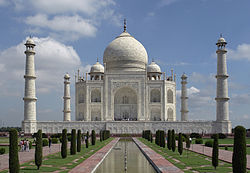
Back Taj Mahal Afrikaans Taj Mahal ALS ታጅ ማሃል Amharic Tach Mahal AN ताज महल ANP تاج محل Arabic تاج محل ARZ তাজমহল Assamese Taj Mahal AST Tac Mahal Azerbaijani
| Taj Mahal | |
|---|---|
 Taj Mahal | |
| Location | Agra, Uttar Pradesh, India |
| Coordinates | 27°10′30″N 78°02′31″E / 27.17500°N 78.04194°E |
| Height | 73 metres (240 ft) |
| Built | 1632–53[1] |
| Architect | Ustad Ahmad Lahori |
| Architectural style(s) | Mughal architecture |
| Visitors | 7–8 million[2] (in 2014-2017) |
| Type | Cultural |
| Criteria | (i) |
| Designated | 1983 (7th session) |
| Reference no. | 252 |
| State Party | India |
| Region | Asia-Pacific |
The Taj Mahal is an Islamic religious building, mosque and tomb in India. It was built in the 17th century by Mughal Emperor Shah Jahan as a mausoleum in memory of his wife, Mumtaz Mahal.[3]
The building is in the city of Agra, Uttar Pradesh. It is widely thought as one of the most beautiful buildings in the world. It is one of India's biggest tourist attractions.
The Taj Mahal is listed as a UNESCO World Heritage Site, together with the Agra Fort, 2.5 kilometers away. It was listed as one of the 7 Wonders of the World in 2007. It is on the south bank of the Yamuna river in Agra.
The building was originally white. Because of pollution, it is turning yellow. Sulphur dioxide in the atmosphere reacts with water molecules and becomes sulphuric acid, which slowly destroys the outer layer of the building. The building also appears to be pink in the morning, yellow-ish in the evening, and gold at night.
The Taj Mahal is one of the most notable examples of Islamic architecture ever built. When it was built, most of India was ruled over by the Mughal Empire except the South. Shah Jahan was a Mughal emperor who came into power around 1628. According to historians, Shah Jahan loved building and architecture, which made his nickname “The Builder Of Marvels”. The Taj Mahal was built for Shah Jahan’s third wife, Mumtaz Mahal- meaning the “Jewel of the palace”. She became ill giving birth to their 14th child. As she was about to die, she asked Shah Jahan to make her the most beautiful tomb that was ever built. She died on 17 June 1631. In 1657, Shah Jahan fell ill. He died in captivity in 1666. His tomb was placed beside Mumtaz Mahal's.
- ↑ Dutemple, Lesley A (2003). The Taj Mahal. Lerner Publications Co. p. 32. ISBN 0-8225-4694-9. Retrieved 7 February 2015.
- ↑ "Archaeological Survey of India Agra working on compiling visual archives on Taj Mahal". The Economic Times. 29 November 2015. Retrieved 16 January 2016.
- ↑ Centre, UNESCO World Heritage. "Taj Mahal". UNESCO World Heritage Centre. Retrieved 2024-08-25.
